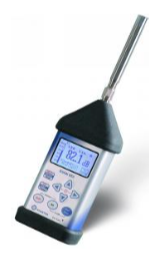Shorcontrol are now Irish agents for the superb Svantek range of sound and vibration analyzers
Short Guide to Buying a Sound Level Meter (SLM)
 The array of features and jargon associated with sound level meters is vast, and to those unfamiliar with them it can be very hard to know what is and what isn’t required. The guide below is intended to cover the most important features of sound level meters, and help you choose what features you need for your particular application.
The array of features and jargon associated with sound level meters is vast, and to those unfamiliar with them it can be very hard to know what is and what isn’t required. The guide below is intended to cover the most important features of sound level meters, and help you choose what features you need for your particular application.
1. – Integrating or Non-Integrating. An integrating meter is one that can
measure an average level over time. (Leq), and is required for any proper
occupational or environmental noise monitoring. A non- integrating meter only displays the instantaneous noise level at any one time, and is only really suitable for spot checks and very steady noise levels. We don’t sell non-integrating meters; if you want one of these try somewhere like Radionics. Note: Integrating is not the same as logging – many cheap SLM’s advertise logging functions, which are of limited practical use.
2 – Accuracy Class. Any respectable SLM should be either Class 1 or Class 2. (aka Type 1 or Type 2) – These designations determine the accuracy and stability of the meter; class 1 is more accurate and preferable if the budget is there, but type 2 is perfectly acceptable for most work. Usually, going from a type 2 to a type 1 increases the price at least €500. A cheap meter with no type designation at all will not have a recognised accuracy class, and will be of limited use, especially if there is any querying of the results. Usually, consultants and others producing work in potentially contentious situations use Class 1 meters.
3 – Frequency Analysis. For many situations, some sort of frequency analysis capability is required, which, in order of increasing sophistication is usually either 1/1 octave (Octave Band) 1/3 octave (One-Third Octave band) or FFT (Fast Fourier Transform) . SLM’s with some or all of these features will give varying degrees of information on the frequency content of the sound, and for some situations this is both desirable and necessary. The two most common situations are:
- Assessing the suitability of hearing protection for very high noise levels (you need 1/1 octave band capability)
- Determining if there are tones present in an environmental noise emission. (you need 1/3 octave band capability) This tonal assessment is sometimes necessary for environmental noise surveys.
As a very rough guide 1/1 octave band capability adds about €500 or so onto the price, and 1/3 octave band capability adds the same on again. FFT, the most sophisticated frequency analysis tool, gives very fine detail on the frequency content of a noise signal, and is useful for noise control and machinery condition monitoring applications, among others.
4 – An Acoustic Calibrator – This is a small device that should be used every time the SLM is operated to verify it is working correctly. These normally cost approx €500 or so, and are absolutely required for any users of a SLM. You might only require one calibrator for several meters if they are going to be kept in the same location. Bear in mind that SLM’s and the calibrators themselves need to be laboratory calibrated once every two years in an accredited lab also.
5 – Dosimeter or SLM. An acoustic dosimeter, or dosemeter, is a miniature integrating SLM that attaches directly to the person whose exposure is being assessed, with the advantage that it can easily be left on for long periods. This is very useful when trying to calculate exposure levels for workers who are very mobile, or who are operating machinery and equipment in such a way that it is not practical or safe to follow them around with a SLM. On the flip side, they are usually not as accurate as SLM’s, and their use has to be monitored carefully to avoid accidental or intentional misuse. They are often used as a supplement to, rather than a complete replacement for the traditional SLM. Some SLM’s can be converted to dosimeters with optional attachments, giving the best of both worlds, and the more advanced dosimeters can actually measure inside the ear under PPE!
6 – Other Applications and Situations.
There are many other types and optional extras available for SLM’s depending on the situation they are required for. The most common are the various weather-resistant kits that provide varying degrees of weather proofing and autonomy for unattended monitoring. There are also many software updates available, that include modules for analyzing reverberation time, loudness, tachometers for rotating machinery etc, and of course you need a tripod if you are doing any kind of environmental monitoring.
Some SLM’s can also be used as vibration meters for measuring Hand-arm and Whole-body vibration as well, with the correct optional accessories. This can be a significant money saver for those who require this capability as well as the ability to measure noise.
- Diesel Engine Exhaust Emissions OELV now Active! - 27th February 2023
- We are Hiring…. - 18th May 2016
- Surgical Smoke-A summary of risks and appropriate control measures - 5th May 2016

